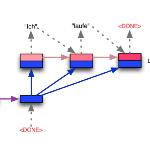Kalman Filter requires the true parameters of the model and solves optimal state estimation recursively. Expectation Maximization (EM) algorithm is applicable for estimating the parameters of the model that are not available before Kalman filtering, which is EM-KF algorithm. To improve the preciseness of EM-KF algorithm, the author presents a state estimation method by combining the Long-Short Term Memory network (LSTM), Transformer and EM-KF algorithm in the framework of Encoder-Decoder in Sequence to Sequence (seq2seq). Simulation on a linear mobile robot model demonstrates that the new method is more accurate. Source code of this paper is available at https://github.com/zshicode/Deep-Learning-Based-State-Estimation.
翻译:Kalman 过滤器要求模型的真正参数, 并重新解决最佳状态估计。 期望最大化算法适用于估算模型参数, 而模型参数在 Kalman 过滤法( EM- KF 算法) 之前是无法提供的。 为了改进EM- KF 算法的精确性, 作者提出了一个国家估计方法, 将长期短期内存网络( LSTM)、 变换器和 EM- KF 算法结合在序列序列( seq2seq) Encoder- Decoder 框架内。 线性移动机器人模型的模拟显示, 新的方法更准确。 本文的源代码可在 https:// github. com/zshicode/ Deep- Lenest- Based- State- Estimation上查阅 。





